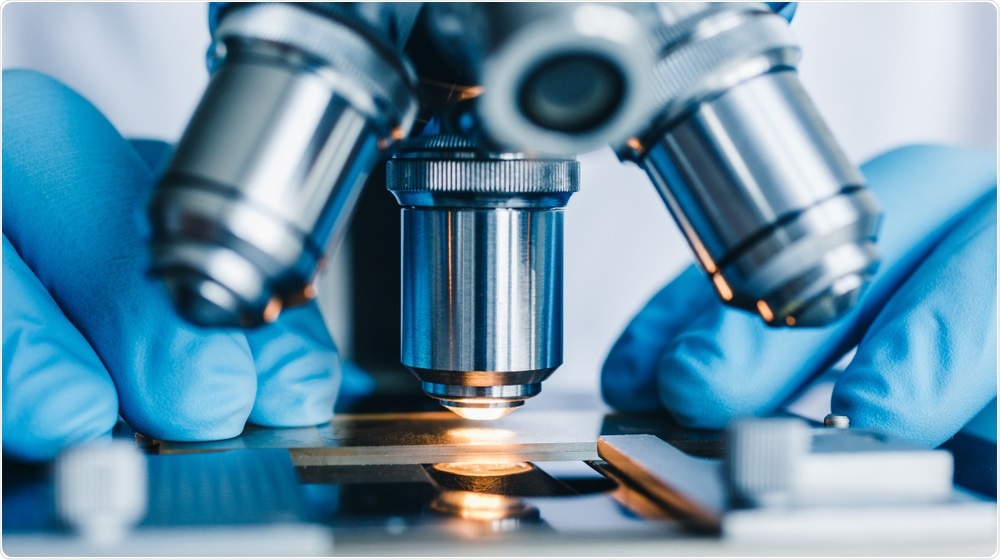A team of biomedical engineers at the University of Connecticut has established a method of lensless on-chip microscopy that overcomes the limitations of conventional optical microscopy.
In a paper published last month in the journal Lab on a Chip, the team describes how their platform provides a cost-effective and sensitive method of diagnosing a range of diseases.

Image Credit: Konstantin Kolosov/Shutterstock.com
Generating a more complete image with ptychographic microscopy
Microscopes have been used for almost half a millennia to enable scientists to observe living things and elements in a high degree of detail, much more than the unaided human eye would ever be able to see.
While this has allowed for significant insights to have been made in all fields of science, traditional microscopy isn’t without its limitations.
In general, optical microscopes are restricted by their limited field of view, usually in the range of one or two millimeters. Tissue samples, however, are generally provided in the centimeter range, this makes the investigation of tissue for disease diagnosis fairly difficult when using standard microscopy alone.
Overcoming this limitation inspired the Connecticut-based team to enhance microscopy so that it can image samples that are more complete. To do this, the engineers aimed to develop a platform without the need of objective lenses, a key component of traditional microscopes.
In removing the lenses, the scientists knew they would be able to achieve a fuller picture of the samples, enabling more accurate diagnoses.
Enhancing traditional ptychography
The team, led by Guoan Zheng, professor of biomedical engineering at the University of Connecticut, developed a diffuser to magnify the tissue sample that was used in place of the lenses.
The diffuser was placed in between the sample and the image sensor where it shifts to different positions as the sensor reads images. The information on the object is encoded and recovered later to develop the image.
To allow them to do this, the team used ptychography, a special kind of imaging technique that illuminates a sample with a focused beam of light and records the patterns of diffracted light that are created. Thousands of patterns of diffracted light are recorded from different positions to develop an entire image.
The method of ptychography has begun to increase in popularity, however, its adoption has thus far been limited due to its relatively slow speeds and the need for accurate mechanical scanning of the sample.
Zheng’s team recognized that these limitations could be overcome by moving the sample close to the image sensor, allowing them to use the image sensor in its entirety as the imaging field of view. Also, it removed the requirement for precise mechanical scanning because moving the sample close to the sensor gave it the highest Fresnel number that has ever been seen in ptychography. High Fresnel numbers are related to very low levels of little light diffraction from the object plane to that of the sensor. This allows the motion of the diffuser to be directly tracked via the raw images, removing the previously required motion stage.
As a result, Zheng’s ptychography technique is more time-efficient and relatively cheaper than conventional ptychography and generates a more complete image than can be achieved with standard microscopy.
Generally, just a small portion of the sample can be viewed in traditional microscopy, preventing scientists from gaining insight into what is happening in the entire segment of tissue. With the improved method, scientists are now able to gain a 30mm2 field of view, a significant improvement on the previous rang of 2mm2.
Automatic cell segmentation
In addition, the newly established platform is also able to work without staining the sample. Usually, this helps scientists to distinguish important organelles, such as the nucleus to identify the number of cells in a sample. With the new method of ptychographic label-free microscopy, this is not necessary because it can achieve automatic cell segmentation.
Future directions
It is expected that the new platform developed by the team at the University of Connecticut will be adopted by healthcare and telemedicine establishments around to world for the benefits it brings. The team also believes their method may be developed for use in X-ray and electron microscopy.
Sources:
Journal reference:
Jiang, S., Zhu, J., Song, P., Guo, C., Bian, Z., Wang, R., Huang, Y., Wang, S., Zhang, H. and Zheng, G. (2020). Wide-field, high-resolution lensless on-chip microscopy via near-field blind ptychographic modulation. Lab on a Chip. https://pubs.rsc.org/en/content/articlelanding/2020/LC/C9LC01027K#!divAbstract